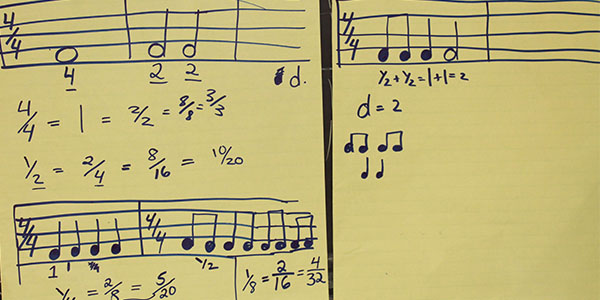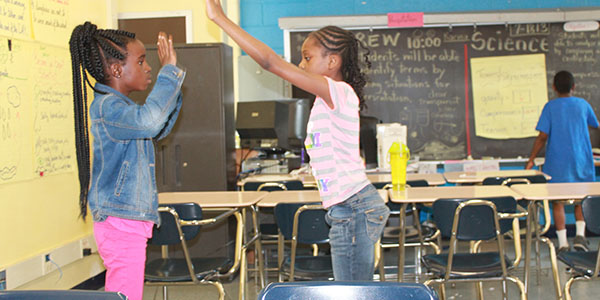Blog

Using arts integration to prevent summer learning loss
By Lucy Coyle

Lucy Coyle recently completed a summer internship at Young Audiences and wraps up our series on Young Audiences’ summer learning programs–and their importance for students who would otherwise have limited opportunities to stay active and engaged during the summer months.
If you’ve seen Jack Black’s teacher impersonator role in the comedy School of Rock then you’ve seen a glimpse of how the arts can engage students in the classroom. In one memorable scene during the movie, Black sings to his class about fractions to come across as a productive and innovative teacher. While in Black’s case the fractions song is all part of a larger scheme to teach students how to rock and not about math, putting mathematic equations to melodies is certainly one way to engage kids in the subject. If you, like me, learned the song “Fifty Nifty United States” at any point in your adolescence–and can still recite all of the states in alphabetical order–you know that arts engagement works.
I had the pleasure of visiting a Baltimore City Public Schools Summer Learning Academy classroom this past July and experienced much more than arts engagement–I saw arts being integrated into the curriculum. Young Audiences again partnered with Baltimore City to provide rising fifth- through eighth-grade students with arts-integrated learning opportunities during the summer months. Through generous funding provided by the Hoffberger Family Philanthropies, Young Audiences was able to expand its role at 10 Summer Learning Academy sites to provide arts enrichment sessions and arts-integrated math and STEM lessons at each site. During my visit to William Pinderhughes Elementary I witnessed how impactful arts integration and summer learning can be when combined.
Young Audiences artist Arianna Ross is a champion for arts integration. She’ll tell you openly that “it’s kind of my thing.” I watched Arianna lead an arts-integrated lesson in a science classroom where students were learning about the concepts of compression, tension, and gravity, which gave me more insight into arts integration and its power to transform classroom learning.
Arianna’s lesson demonstrated that the bounds of arts integration are almost limitless. For Arianna, it’s not just about putting the names of the states or fractions to music, but rather it’s about expressing various concepts in as many ways as possible.

Although Arianna is listed in the Young Audiences’ Resource Guide as a storyteller, she is the first to dismiss traditional storytelling methods when a dance activity or a poetry-writing session better serves the subject at hand. For Arianna, arts integration is about adapting every day to fit the curriculum. It’s about bringing arts terms into the classroom and using them on a regular basis.
I saw Arianna use various dance and theatre terms during her lesson on physics. Students began by standing in mountain position–the actor’s resting position. They paired off and created physical representations of the concepts being discussed in the class: gravity, compression, and tension. While they explored different poses that communicated these concepts, the students physically connected to the importance of strong foundation and balance. Their choreographed dances helped them make abstract physics concepts concrete, and they were more eager to participate and share what they had learned by performing for one another.

Baltimore City Public Schools Summer Learning Academies were designed to give students five weeks of additional math support during the summer. Many of these students come from low-income backgrounds and are in danger of summer learning loss, the well-studied phenomenon of students losing two to three months of math and science material learned the previous school year during the summer when intellectually engaging activities are not as readily available. As an incentive, the Baltimore City program also gives students free access to opportunities in the arts, sports, and robotics.
While the arts are an incentive for students to join the program, arts integration is doing much more than encouraging students to attend–it is helping students understand tough concepts by engaging them in new ways.
We want to hear from you!
Have you ever taken part in or led an arts-integrated activity in a classroom? Did using the arts challenge your mind to make nontraditional or creative connections in a traditional subject? Do you think the arts can help students gain agency when studying math and science?
Read more posts about Young Audiences’ summer learning programs here.
Lucy Coyle is a senior at Johns Hopkins University, majoring in International Studies, and recently completed a summer internship at Young Audiences.








